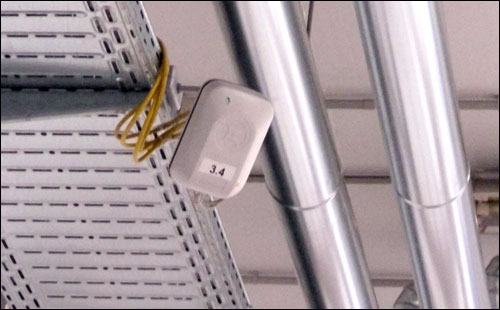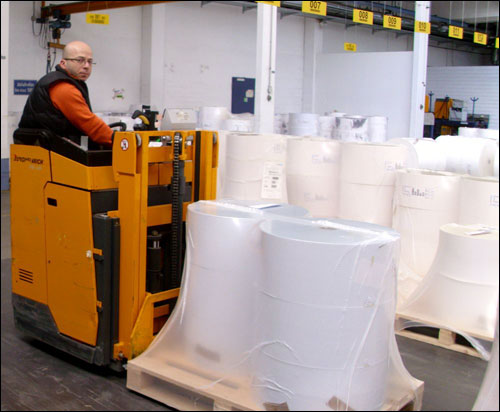Mar 22, 2011Since implementing a real-time location system (RTLS) last June, Herma, a German manufacturer of adhesive labels, has increased the number of pallets that it ships daily by 67 percent, to 500, while also reducing the quantity of shipping errors reported by its customers each month from 50 down to 7. The solution that helps the company accomplish this improved efficiency and error reduction, provided by Ubisense, does so not by tracking the locations of pallets loaded with product as they move through the facility to awaiting trucks, but rather by tracking the forklifts that transport them.
Herma, based in the city of Filderstadt, is one of the largest label manufacturers worldwide, and continues to increase its production of self-adhesive products for use in offices, schools, printing shops and homes. The firm sells its products to customers throughout the world in the form of large rolls. When the products are shipped, the rolls—which are typically several feet in size—are loaded onto pallets and stretch-wrapped. Next, a bar-code label is attached to the stretch-wrap surrounding each pallet, which is then scanned to link that pallet with a particular product loaded onto it, as well as with the order it will fulfill. The pallet then moves several times through the warehouse, until a truck arrives to transport it to a customer.
To identify the proper pallet and ensure that it is being loaded onto the correct truck, a forklift driver read the serial number printed on the pallet's bar-coded label (for redundancy's sake, each bar-coded label was also printed with the same serial number in human-readable form). The driver then compared that serial number against those listed on the order's paperwork. This, however, was a slow process that allowed mistakes, says Frank Baude, Herma's manager of logistics and customs, since many products on the pallets look the same and are thus difficult to differentiate without utilizing a bar-code scan.
Ubisense—according to Holger Hartweg, the company's account manager—met with Herma in 2009 to discuss an automated solution using Ubisense's battery-powered RFID tags that would help Herma's staff locate loaded pallets and ensure that the right product was being loaded onto the correct truck. "We thought we'd put a tag on each pallet," he explains, "and each time a pallet came from production, we could read the label." The cost of installing a Ubisense battery-powered tag onto each pallet, however—which would be shipped out and not returned—made this plan too expensive. "We needed a good way to get tags back from the pallet," he says, but could not figure out a method for doing so.
Instead, Ubisense and Herma came up with a new plan: using Ubisense RFID tags and readers to track the whereabouts of forklifts as they move the pallets, thereby recording where in the warehouse a pallet was picked up and deposited, and thus indicating the product's location. The resulting solution included the installation of two dozen Ubisense sensor nodes (readers) on the ceiling throughout the 750-square-meter (8,703-square-foot) facility, as well as fitting each of its seven forklifts with four Ubisense tags and a terminal with a display screen for providing instructions and location data to drivers. Ubisense software handles the flow of information to and from the forklift readers, while Herma's SAP-based back-end software manages the company's order data, as well as the location and identity of each pallet, based on the Ubisense solution.
When the forklift arrives in front of the appropriate pallet, the driver uses a handheld bar-code scanner to read that pallet's label and forwards that information via a Wi-Fi connection to the Ubisense software residing on Herma's back-end enterprise resource planning (ERP) system. The pallet's bar-code serial number is compared against the number on the order, and if the order is correct, Ubisense software then instructs the driver as to where the pallet should be delivered. If it is not the correct pallet, a warning is displayed on the screen and the driver can then continue seeking the correct pallet.
After picking up the pallet, the driver presses a prompt indicating he has begun transporting it to its destination. Each of the forklift's Ubisense ultra-wideband (UWB) RFID tags transmits a 6 to 8 GHz UWB RF signal encoded with a unique ID number linked to the vehicle's ID in the Ubisense software.
Once the driver has the proper pallet, he can then take it to the necessary location—for example, a staging area used prior to the loading of the trucks—indicated on the forklift screen. After placing the pallet onto the floor of the assigned location, he then presses a prompt on the screen indicating he has delivered the pallet as instructed, and as the tag transmits its signal to nodes in the vicinity, the Ubisense software calculates the location at the time of deposit, based on sensor node data, and then links that information to Herma's SAP software. Because the forklift is fitted with four tags—one on each corner of the vehicle—the system can identify its location to within approximately 30 centimeters (12 inches), and can determine its orientation as well, thereby knowing in which direction the forklifts are pointed, and thus exactly where the pallet was deposited.
When the pallet is ready to be loaded onto a truck, the process is the same, with the driver pressing the prompt on his screen as he places a pallet into the vehicle. At that time, the software calculates the forklift's whereabouts, thereby determining onto which truck the pallet has been loaded.
The system provides two benefits, Baude says. "We are able to send more pallets out with the same number of workers," he states, since less time needs to be spent checking ID numbers and comparing them against the numbers of a paper order. In the past, he notes, drivers had to travel through a warehouse searching for a pallet, rather than being directed to its specific location, and once the pallet was located, its identity then had to be verified manually (via a handheld bar-code scanner, or by visually checking numbers) rather than automatically, as is the case with the new system.
This increased efficiency is critical, Baude says, because of the company's goal of shipping about 800 pallets daily in the coming years. Herma expects that the RFID system will make this increase in volume achievable. Consequently, he says, the company plans to acquire three additional forklifts, and to install the Ubisense system on each vehicle.
"I'm very happy with the results," Baude says, regarding the system's performance. "We also have much more satisfied customers," he adds, thanks to a decrease in shipping errors.





